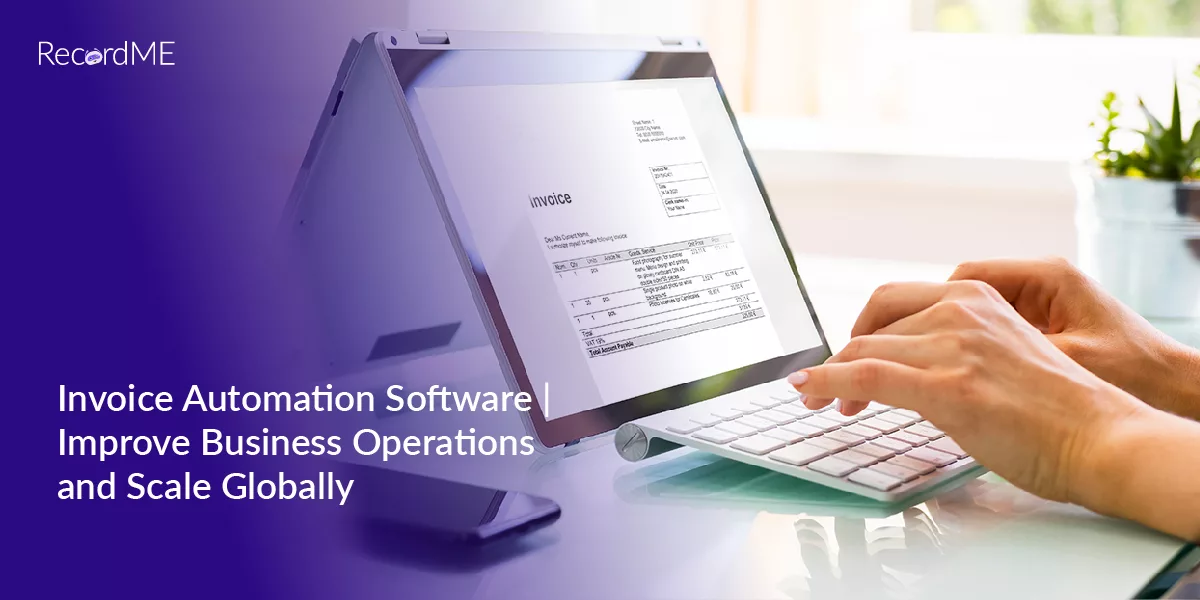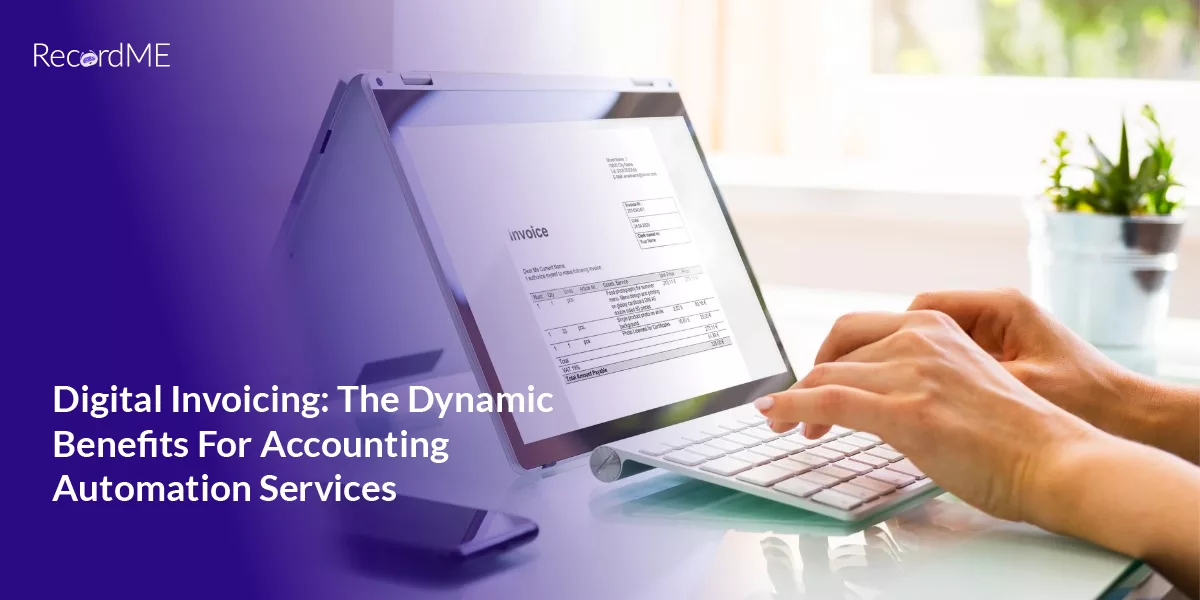How Automation is Transforming the Future of an Invoice Processing System?

In This Post
When accounts payable and receivable were handled manually, businesses would waste a lot of time fixing errors made by data entry clerks. Manual data entry has an error rate between 0.55% and 3.60%, wasting time and damaging reputations. Financial institutions can benefit from an automated invoice processing system by centralising billing management tasks.
Invoice automation software will revolutionise invoicing, receipt generation, and other financial management tasks using AI and ML algorithms. In this article, let’s deep dive into how artificial intelligence is transforming the landscape of billing software.
A Deep Dive into the Invoice Processing System
Invoice processing refers to all the steps between receiving and paying a bill. It could appear simple at first glance. There are, however, other steps in between, and depending on the scale of the enterprise, these practices can quickly become convoluted.
These days, consumers can receive an invoice in several different digital and physical formats. Filing, recording, and approval by an appropriate party are prerequisites to payment. The more individuals work for the company, the more intricate this process becomes.
An invoice processing system receives, authorises, defines a remittance date, pays, and enters a supplier invoice into the general ledger. It’s crucial to the success of any enterprise.
To prevent disruptions in delivering services, supplies, and raw materials and to preserve positive relationships with vendors, timely payment of vendor invoices is essential. That is understandable if a business receives an amount even a little late once or twice.
The Invoice processing system helps accounts payable departments manage vendor or supplier invoices from receipt to payment and general ledger entry.
An automated invoice system helps account payable and receivable departments handle payments with software. Moreover, according to the survey, the money spent on E-invoicing services is expected to reach $20 billion by 2026. A flowchart outlining the steps accounts payable takes to handle billing statements from suppliers is known as an invoice processing flowchart.
The Many Challenges of Manual Invoice Processing
Any account payable team will have its fair share of difficulties when using the manual invoice processing system. The workplace becomes tense and high-stakes when things build up. Businesses need to know the ins and outs of these problems and avoid them in the future.
Let’s take a look back at the difficulties that have arisen as a result of using a manual invoice processing system.
-
Payment Delays
Despite the digital-first disruption, many businesses still need an updated invoice processing system, such as paper-based methods. There is a lengthy approval schedule for invoices because they must be sent across agencies.
A supplier’s cash flow, as well as their level of satisfaction and loyalty to an organisation, can all take a hit when payments are delayed. This causes more stress and work for people in accounts payable at companies. They may even be subject to monetary fines. They can take measures to reduce wait times, such as better coordination between departments and planning for future payments. Mistakes will undoubtedly be made as long as bills are processed by hand.
-
Fraud Risks
The average annual loss due to fraud is $125,000, and the Association of Certified Fraud Examiners (ACFE) estimates this figure is closer to 5% of sales. The accounts payable division is highly susceptible to theft.
The expansion of the digital-first economy in recent years has coincided with a sharp increase in the frequency of cyberattacks. In 2020, 74% of businesses fell victim to payment schemes. To steal money, cybercriminals frequently pose as businesspeople or vendors.
-
Matching Errors
It is usual practice to compare the supplier’s invoice, the product’s receiving note, and the purchase order before approving payment. The purpose of three-way matching is to find inconsistencies among these submitted files.
Human error in the form of wrong or missing information occurs frequently when accounts payable teams must do this manually. It’s bad enough when the items have yet to arrive, but it’s even worse when the AP department gets the invoice. Fixing a problem like that takes a lot of effort and time.
-
Missing Invoices
Invoices sent by traditional mail often need to be found en route to the office or among other documents. Invoices that have gone missing must be recovered before payment has to be made. The AP staff’s search for them will be time-consuming and stressful. Furthermore, this harms the company’s connection with the supplier and disrupts the supplier’s cash flow.
When an invoice states a different amount, missing or unissued purchase orders can make it challenging to show an agreed-upon amount. The time-consuming process of issuing purchase orders is often neglected.

How Automation Revolutionises the Invoice Processing System
Businesses must use an automated invoice processing system when dealing with dozens or even hundreds of billing statements daily. Invoices are an essential tool for any business. An accounting company can learn about its accounts payable and receivable through the invoices it receives and creates.
All data connected with taxes can be found in one central location with the help of invoice automation solutions. Having to enter invoices manually can significantly disrupt business operations, which is why e-invoicing software is essential.
The advantages of an automated invoice system are as follows:
-
Quickly Access and Maintain Digital Data
Digitally storing valuable sales receipts allows companies to combine receivables quickly. Even though they have multiple offices, they can continuously monitor their cash flow from anywhere.
The central storage of these invoices would allow for the availability of combined accounting data. However, according to a study, nearly a third of practitioners expect to eliminate 25% to 50% of paper invoices from suppliers shortly. An online invoice generator guarantees timely and accurate entry of billing information.
-
Real-Time Information
Each invoice gets a timestamp when it’s entered into the system due to the automation of the billing process. Once an invoice has been approved, no modifications can be made. The accounting procedure is now automated and standardised due to this.
These invoices could be linked to data stored in other ERP modules to streamline accounting processes. Thus, B2B and B2C organisations can only use automated invoice processing systems.
-
Efficient Reporting Process
Because of digitisation, crucial data is reliably stored in a database. However, management can access this information for various comparisons and reporting purposes, mainly using specialised software for handling invoices. Thus, management receives clear reports based on actual data in multiple formats for taxation and other legal purposes.
Automated Invoice Processing System – What Does the Future Hold?
To streamline their bookkeeping processes, financial institutions are implementing cutting-edge AI algorithms. Future invoicing systems will likely incorporate the following technologies.
-
Advanced AI and Cognitive Technologies
Natural language processing (NLP) and cognitive technology are two cutting-edge AI capabilities that will shape the future of an automated invoice processing system. These technologies will let systems contextualise invoice content, make intelligent decisions, and manage complex problems autonomously.
-
Blockchain – A Reliable and Transparent Technology
Blockchain technology can drastically revolutionise invoicing by generating an irreversible and comprehensive record. Using blockchain technology, organisations can verify the legitimacy of invoices, reduce the risk of fraud, and accelerate payments between companies.
-
Analytics and Predictions for the Future
Automated systems can estimate cash flow, identify payment trends, and enhance working capital management using predictive analytics on big invoice data sets. As a result, firms may make better financial decisions and prepare for any problems.
How Can RecordMe Help?
RecordMe, the AI-powered Financial Bot, AI-powered Financial Bot, provides cutting-edge invoicing and expense-tracking software. RecordMe’s many features and advantages make it an excellent tool for improving accounting procedures. Here’s how:
- Efficiency and Time Savings: Facilitates rapid and error-free invoice processing
- Compliance With Greater Accuracy: Prevents fines by requiring timely invoice processing and attention to detail.
- Prioritisation: To help you avoid paying late fees, it sorts your invoices by their due dates.
- Reduce Cost: Provides software to automate invoicing, saving money by eliminating human accountants’ assistance.
- Improved Workflow Efficiency: Finds inefficiencies in your operations, increases performance, and decreases mistakes.
- Fraud Detection: Monitoring of financial activities in real-time to reduce the possibility of fraud
- Invoice Automation: Reduces the time spent on accounting-related tasks, boosts transparency, and strengthens ties with vendors.
Still, battling to figure out how to make more informed and timely billing decisions? Contact Us!



